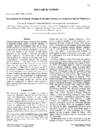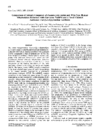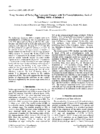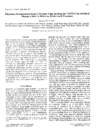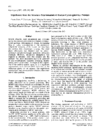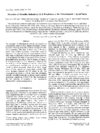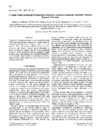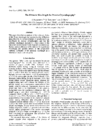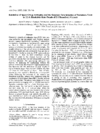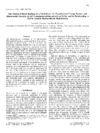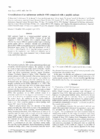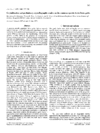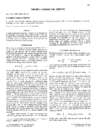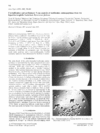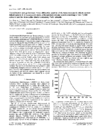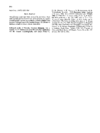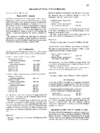issue contents
November 1997 issue

Cover illustration: View of interdomain interface of cell adhesion molecule VCAM-D1D2. The two hydrophobic patches (yellow from domain 1 and orange from domain 2) allow the domains to rock back and forth around the `pivot' residue Tyr89. The long C'E loop and FG loop seem to guide the movement. Courtesy of Jia-huai Wang.
research papers
The pattern and variability of backbone packing density in protein structures are examined. An interesting correlation between the average percentage composition of amino acids and the percentage composition in regions corresponding to different levels of packing density has been observed.
The novel furopyrimidine antifolate (MTXO) has been studied as inhibitor-reduction ternary complexes with Pneumocystis carnii and with recombinant human wild-type dihydrofolate reductase. There is a significant change in the nicotinamide ribose conformation of pcDHFR resulting in a close 4NH2 inhibitor-O contact not found in human DHFR.
PDB reference: 1oaj
X-ray structure of turkey egg-white lysozyme complex with tri-N-acetylchitotriose revealed the lack of protein-sugar contact at subsite A. The result indicates the crucial role of the subsite A in regulating the cleavage pattern of oligosaccharides in the catalytic form.
PDB reference: 1jef
An unusual molecular association is induced in cytochrome c' from Rhodobacter capsulatus strain St Louis by bridging Zn ions.
PDB reference: 1cpr
C ALPHA, a program for rebuilding protein structures from C α traces is described and its accuracy assessed from test reconstructions. Uses of the program are considered and in particular the use of such a reconstruction to aid the initial phasing of a data set using a molecular replacement procedure is examined in detail.
A program ANOMIR is described which derives phases from anomalous scattering and/or isomorphous replacement data and contains a number of new features and techniques.
Experiences from the structure determination of HCMV protease may prove useful to the solution of other protein structures.
Static and dynamic light scattering were employed to investigate the behaviour of lysozyme solutions when varying the concentration of two different electrolytes for screening the repulsive forces between the monomers. Mass fractals coexist with monomers and small lysozyme oligomers in these solutions. Based on the correlations between the various observables we attempt to predict the long-term fate of the nucleating solutions.
We have employed static and dynamic light scattering to investigate the behaviour of nucleating lysozyme solutions which form mass fractals coexisting with monomers or small lysozyme oligomers. Based on tentative correlations between the observables we attempt to predict whether the examined solutions will crystallize or not.
The structure of orthorhombic crystals of monellin, a sweet protein extracted from African serendipity berries, has been solved by molecular replacement and refined to 2.3 Å resolution. The structure was compared with those of monoclinic and single-chain monellin, showing little influence of crystal packing forces.
PDB reference: 4mon
Crystals have been grown of a cyanobacterial pigment protein that only binds carotenoid and may serve a photoprotective role.
Crystals of the sweet protein thaumatin grown in a microgravity environment have a larger volume and are less in number than earth-grown controls prepared in parallel. Their diffraction properties are improved they diffract X-rays to a higher resolution and their mosaicity is significantly lower.
This paper describes an analysis of the optimum choice of the X-ray wavelength for macromolecular diffraction data collection.
The space-group ambiguity in monoclinic nodamura virus crystals has been resolved and the structure determined to 3.3 Å resolution.
Stepped growth rates and crystal movements have been observed by CCD video in microgravity lysozyme protein crystallization experiments which correlate with `g-jitter' accelerations, especially of low frequencies. The spurts and lulls of crystal growth may, therefore, explain the residual mosaic block structure seen in protein crystal mosaicity and topography measurements.
The structure determination for Trypanosoma brucei phosphoglycerate kinase ternary complex relied on a unique protocol in which search probes containing as little as 8.4% of the scattering mass were sequentially positioned in the unit cell to obtain phases.
The results of an experimental charge density analysis of 1H+-adeniniumtrichlorozinc(II) are reported and compared with results from a similar study of adenine hydrochloride hemihydrate published earlier. It is shown that the dimensions of the imidazole ring are significantly perturbed upon complexation, the lone-pair at N7 is not coplanar with the base and positive electrostatic potential in the complexed base extends further from the molecule. Some consequences of these changes are discussed.
crystallization papers
The use of ethylene glycol as an additive in the crystallization of penicillin acylase results in a new crystal form in the monoclinic space group P21.
Crystals of the Fab fragment of the SM3 antibody complexed with the peptide epitope were obtained in space group P21. Crystals diffract up to 1.9 Å resolution.
Recombinant glucoamylase from Saccharomycopsis fibuligera has been crystallized. The crystals are orthorhombic, space group P212121 with cell dimensions a = 58.1, b = 87.8 and c = 99.9 Å and diffract to 1.7 Å resolution.
The S. cerevisiae phospholipid transfer protein Sec14p has been purified and crystallized. Native data and dat from two heavy-atom derivatives have been collected.
A mannose-specific lectin from the bulbs of garlic has been crystallized. Preliminary crystallographic studies including structure solution using molecular replacement have been carried out.
short communications
A simple method is proposed to discriminate the intermolecular vectors in the cross rotation function, which can be incorporated into existing molecular replacement packages.
An iterative procedure for combining direct methods with the solvent-flattening technique is proposed. The new procedure has been compared with other procedures using experimental protein data.
Chicken egg-white lysozyme has been shown to be readily crystallizable in both the tetragonal and orthorhombic forms by ammonium sulfate over the pH range 4.0-7.8.
A human type methionine aminopeptidase from hyperthermophilic bacteria has been crystallized in four different forms.
The heterotetrameric dehydrogenase B from Lactococcus lactis has been crystallized. Diffraction data have been collected to 2.2 Å resolution.
Erratum to Acta Cryst. (1997). D53, 355-363.
books received
Free 

international union of crystallography
Free 



 journal menu
journal menu









